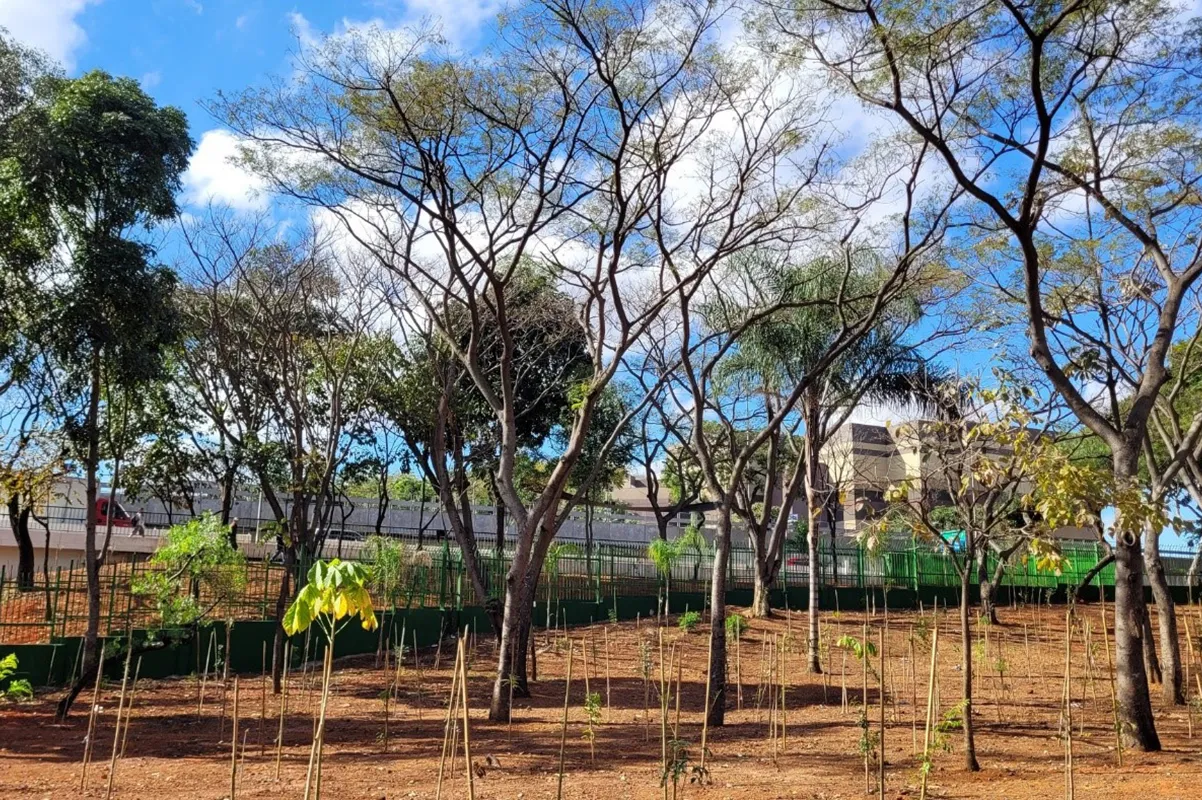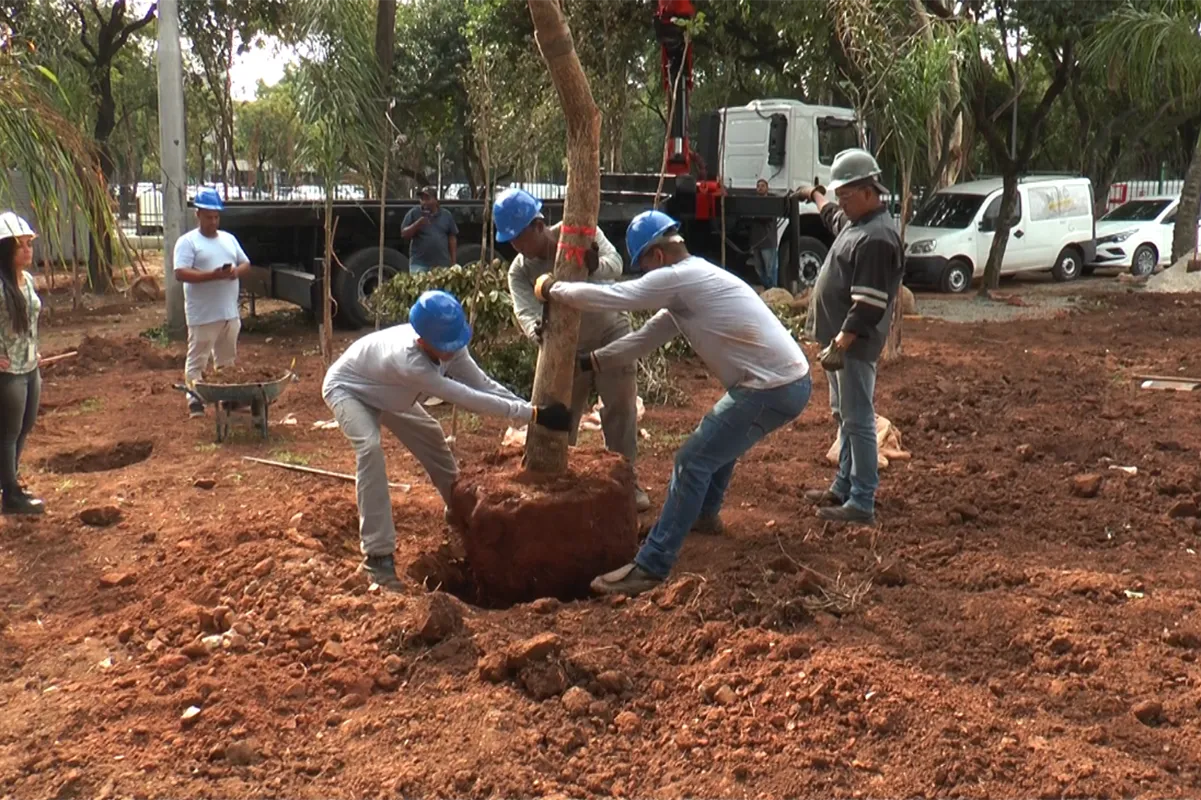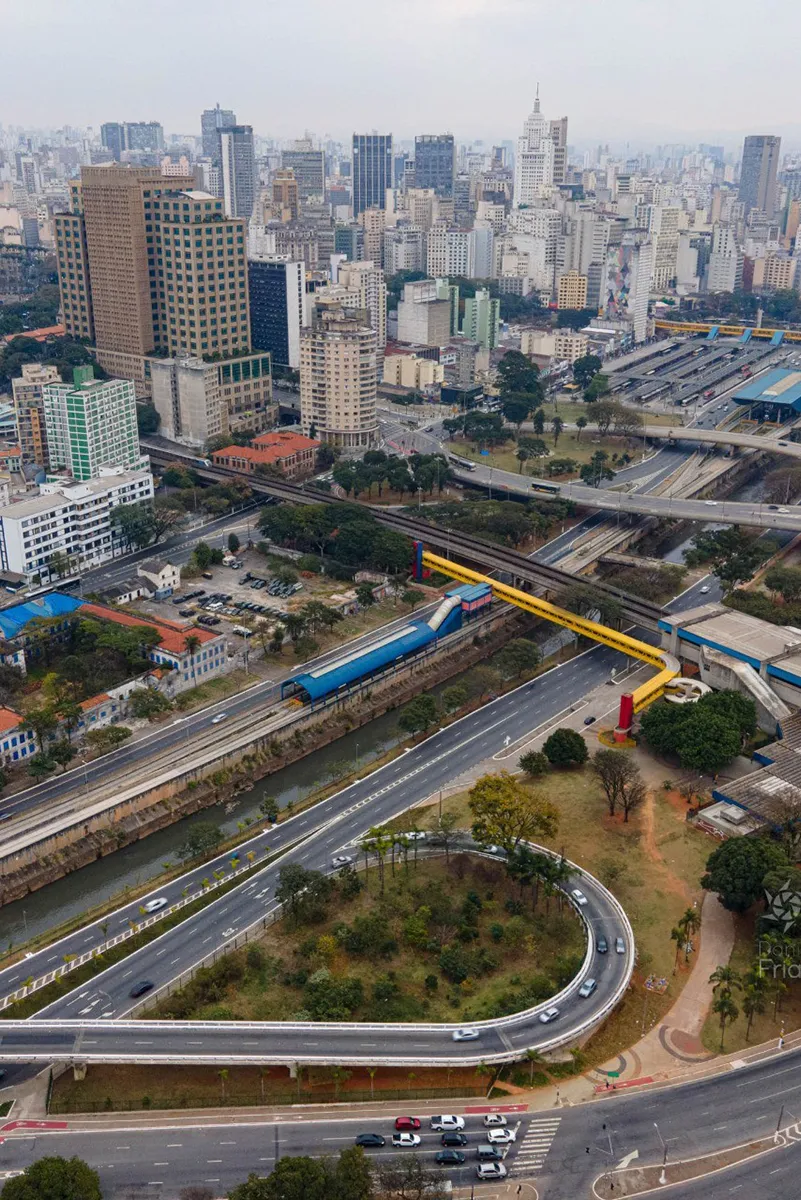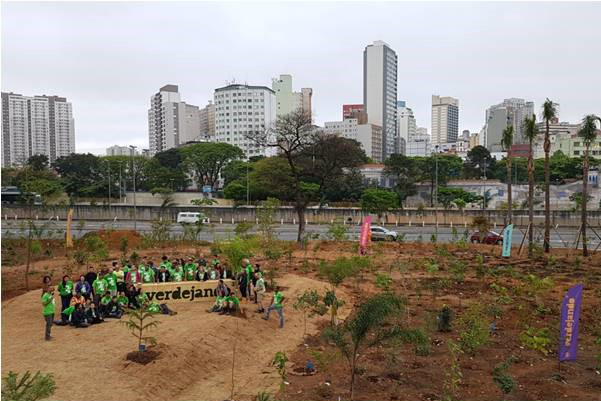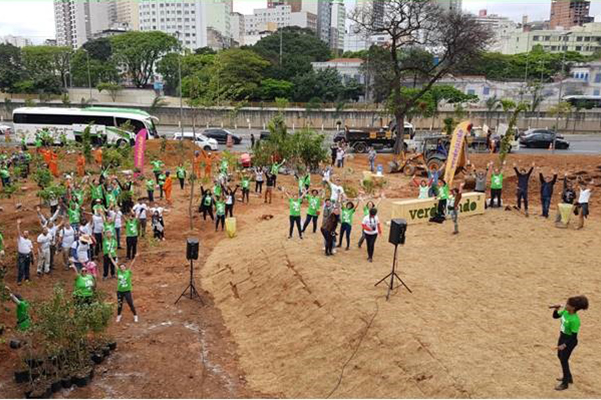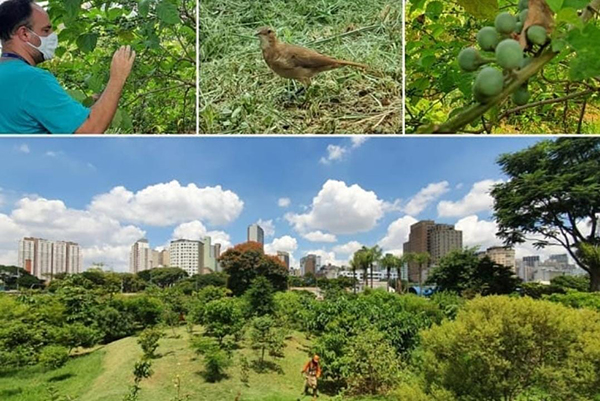Benefits of Urban Greening
Harnessing the Power of Plants
According to data, most greenhouse gas emissions in Brazil (carbon dioxide, methane, nitrous oxide and water vapour) are caused by deforestation (approximately 30% of carbon emissions). The problem can be mitigated or even reversed by reforestation, combined with changes that rethink the current social and consumption model. Studies by the Intergovernmental Panel on Climate Change (IPCC) attest that “many impacts of climate change could be avoided if global warming were limited to 1.5ºC. However, this would require rapid and profound changes in society to reduce CO2 emissions by 45% compared to 2010 by 2030”. CO2 is the gas that contributes most to the greenhouse effect, hence the importance of finding effective mechanisms to remove it from the atmosphere.
Nature has a perfect mechanism. Trees!
All plants capture CO2 through photosynthesis and store it, which is why wetlands and forests are the largest reservoirs of CO2 on the planet. From this perspective, Urban Conservation Forests are powerful tools against the greenhouse effect. After one year of life, the Bosque das Maritacas (1st to be created in 2019) has removed approx. 8,573.25kgCO2eq from the atmosphere, and the estimate is that it will remove approx. 39,479.55kgCO2eq from the atmosphere by the end of the 5th year.
The Bosques and other initiatives (rain gardens, biovalets, green spaces and other municipal SBNs) aim to promote a greener and more sustainable city, capable of giving its inhabitants more comfort and joy.
Delivering Multiple Benefits
To exploit other benefits, the seedlings in the Conservation Forests are planted in random order, with different spacing, which can vary according to the terrain. The plantations are arranged in various ways, according to the species (endangered, rare, fast-covering species, according to their successional class (pioneers and non-pioneers), and dispersal syndrome, ecology (functional group).
Another benefit provided by the Urban Conservation Forests is that they act in conjunction with the permeability micro-basins created by the rain gardens, with an emphasis on harvesting and reserving rainwater.
To exploit this potential, its topography has been adapted to form “basins” and prevent the water collected on its surface from going into the rainwater galleries, infiltrating all of it into the ground, irrigating the native tree seedlings planted and minimising the effects of flooding in the areas downstream. This expands the city’s permeable coverage areas, slowing down surface water and reserving this water underground, which can then be reused by the existing vegetation. In the Urban Conservation Forests, this situation is easily observed.
In 2021, both conservation woods and rain gardens became public policy in the city of São Paulo, increasing the number of projects for new spaces, ensuring the creation of more city-type spaces and benefiting the population of the city of São Paulo.
The City’s Bold and Innovative Vision
This innovative, simple initiative implements urban green infrastructures and SBNs in areas under the responsibility and scope of the municipality, defining specific actions that can be generalised in the urban fabric through regional public execution.
The concept defines a new type of Conservation Unit. Instead of creating large areas (rare in large urban centres), small environmental preservation units are created, which act as biodiversity hotspots, especially for birdlife (approx. 496 species recorded per sighting). Together, these Hotspots have great environmental potential and serve as resting, feeding and nesting sites.
The Bosques also favour the “inversion” of the sidewalk, removing it and increasing urban permeability, i.e. removing asphalt and implanting burlap, organic compost and vegetation.
Social support was also a strong point in the program to establish the forests. The first three were planted in joint actions with the population, through public and private organisations.
“We are building a greener future for our city centre with urban conservation groves and rain gardens. The population will benefit from spaces that were once grey and now have the varied colours of flowers, the sounds of birds and the beauty of trees.” – Roberto Arantes.
Partnerships and Collaboration
Like any public policy, the initiative is supported by the entire technical structure of the Municipal Secretariat of Sub-prefectures (SMSUB), which relies on teams from individual sub-prefectures. This technical team includes biologists, agronomists, architects, geologists and others (ATOS), financial, legal and inspection professionals, among others, who work together to prepare information (memorials, public notices, spreadsheets and all the necessary documentation) so that the forests can be set up in the city.
The initiative also counts on the participation of stakeholders from outside the green spaces sector, such as project supervision companies, hired to support this and other urban project and construction initiatives, which also count on professionals who certify the viability of each project. This technical and administrative expertise has the guidance and coordination of the Cabinet team, in the form of the Executive Secretary and, ultimately, the Secretary of SMSUB.
The forests rely on a great deal of acceptance and support from the private sector, various third sector organisations and countless volunteers, especially volunteers from urban gardens and forests, whose planting groups are scattered throughout the city and always join forces with SMSUB to carry out these actions. Previously, Rede Globo’s “Verdejando” initiative helped plant the Bosque das Maritacas, giving it great national visibility. In 2020, the Bem-te-vi Forest was planted with the help of the State and Municipal Education Departments, with the students choosing the name and planting the saplings.
Addressing Urban Challenges
The Issue
In São Paulo, the country’s most populous city, with 11,451,245 inhabitants (2022 Census/IBGE), pressure on ecosystems, urban expansion and consumption are at the top of the capital’s list of concerns when it comes to mitigation policies for the effects of climate change. Climate change affects the availability of water, generates heat waves, aggravates symptoms of respiratory syndromes during periods of drought and, during periods of rain, causes floods and landslides, aggravating socio-environmental fragility.
The Impact of the Issue
São Paulo, like other large cities around the world, is facing a huge environmental challenge. The pressure on natural resources has resulted in significant impacts on the different ecosystems and the city’s population. The city suffers from extreme events such as flooding, landslides, continuous periods of drought and the worsening of the heat island phenomenon. Each season (summer/winter), these problems become more evident.
Industries, motor vehicles and other forms of pollution are responsible for the daily release of tons/year of atmospheric pollutants.
A Nature-Orientated Future
It was never imagined that the issue of heatwaves, accelerated urbanisation and the rigours resulting from climate change would be resolved by actions such as the implementation of Urban Forests. Yet, their systematisation in the city, by taking advantage of areas that are not regularly used by the population for leisure or recreation, increasing permeability, afforestation and biodiversity, can mitigate a large part of the climatic extremes in the urbanised area.
The increased vegetation cover makes it impossible for the sun’s rays to heat floors and asphalt, minimising heat radiation from these surfaces, which regulates the availability of water in the air of the metropolis, improving wellbeing and breathing conditions. At the same time, the treetops act as a buffer against heavy rainfall, dissipating energy and increasing water retention in the leaves and soil, which allows for greater absorption and less surface runoff, minimising flooding.
Woodlands only bring benefits: climatic, environmental and urban functionality, as well as adding beauty and wellbeing to the city’s landscape.
The implementation of Urban Conservation Forests transforms asphalt into urban gardens and cement into permeable areas, whose topography is adjusted to reserve rainwater (“sponge” pockets), receiving it and slowly releasing it into the soil, minimising the effects of flooding in downstream areas. These are low-energy techniques (SBNs), but highly effective.
The forests are primarily made up of the most effective tools for combating climate change – trees! The first eight forests will remove approximately 28,802.9 kgCO2eq from the atmosphere in their first year.
The initiative, together with other public policies based on SBNs, seeks to minimise or solve problems arising from extreme climatic actions. As well as seeking greater urban functionality, investing in improving the quality of life of the population and increasing the aesthetic beauty of the city’s landscape.
The aim is to enhance the living environment, with attitudes of wellbeing, in which vegetation plays a priority role.
Nature Positive Solutions
Implementation
After defining the areas that are suitable to receive the Urban Forests, their topography is adjusted to form retention “basins”, increasing the capacity to collect rainwater. All the plant species planted are native to the Cerrado and Atlantic Forest biomes, which form the ecosystem base of the region in which the capital is located.
Once the soil has been decompressed, corrected and organically fertilised, the seedlings are planted and/or the adult plants are transplanted. The planting, in accordance with the specialised literature, is carried out in random order, with different spacing, which varies according to the environmental interest and according to the species (endangered, rare, fast-growing species, depending on their successional class (pioneers and non-pioneers), dispersal syndrome, ecology (functional group), availability of seedlings, nitrogen-fixing species.
After planting, a layer of mulch is always applied, made from the remains of tree pruning and other plant waste, with the intention of allowing the planted seedlings to develop better. Grasses are controlled, the manual removal of undesirable species is periodic and the planting of native forage is intensified.
Once the woods have been consolidated, after the first five years, they will be opened as educational and research environments, for monitored visits (by appointment). The Bosque das Maritacas, created in 2019, already has specimens over 10m tall with a wide canopy. The maintenance and management of the woods is the responsibility of the Subprefectures.
Feasibility
The economic feasibility of a project is determined by various factors, both internal and external, which must be well planned to ensure its continuity over the years. Once the Rain Gardens (2021) and the Urban Forests (2023) have become public policies of the city, their economic viability can be projected within the municipal budget, which brings more security and certainty to investments in this type of environmental initiative.
The municipality took into account the city’s acceptance of the unprecedented environmental policy, the possibility of revitalising various urban areas that are unused by the population and that play a significant role in the construction of São Paulo’s landscape when drawing up its investments and achieving official targets. The innovation and benefits provided ensured continuous financial and logistical support, with a view to meeting both short and long-term goals.
The huge presence of birds, insects and other elements of São Paulo’s fauna in the new forests demonstrates the potential for biodiversity within the city, enabling ecosystemic and biological functions and aspects related to urban biophilia.
Multi-Stakeholder Support
The initiative is supported by the entire technical structure (areas and sectors) of the Municipal Department of Subprefectures (SMSUB) and other residents’ associations, urban planters, urban garden managers, third sector entities and private companies.
Civil society was represented by various groups of planters from different parts of the city, students and teachers from the state and municipal public schools (involved in the 2020 state planting program – 1 tree per student finishing the 1st year of primary school). The international NGO Keren Kayemet LeIsrael (KKL) was the protagonist of plantings in the woods and on other occasions with the SMSUB team and the Sé Subprefecture, as well as consulates (Israeli, Syrian, Korean) and various other supporters, which has had a positive influence on the activities carried out and new people interested in taking part in similar actions.
The involvement of private stakeholders and civil society has a significant and positive effect on the actions implemented, as they provide support and visibility for all the activities on the municipal environmental agenda.
And, have a far greater reach than the City Council would be able to achieve individually, giving greater legitimacy and recognition to the actions.
This is an interdisciplinary/multilevel/multisectoral collaboration that makes it possible to broaden participation, dissemination and the sharing of environmental ideas and interests. Such partnerships strengthen actions and increase planning, logistics and communication needs, as they expand socio-cultural interconnections and their power to influence more people.
Management and Maintenance
In 2019, the Urban Kindness Program, developed by the Sé Subprefecture, implemented green infrastructure modalities in the central region of the capital to mitigate the effects of flooding and expand the functional capacity of the urban landscape, whose creators and technical managers are Biologist and Landscape Architect Andre Graziano.
Among the actions for urban intervention and environmental recovery, the Nature-Based Solutions (SBNs), involving the creation of urban micro-environments (green spaces), rain gardens, biovalets, among others, gave great prominence to the implementation of Urban Forests.
This program stimulated the development of new nature-based actions, seeking a better cost-effectiveness ratio in urban management works when compared to grey infrastructure works (combining “green and grey” works) to maximise the benefits and efficiency of drainage and sustainability systems.
It also trained the technical teams involved in the works, so that the knowledge and practical application could be replicated throughout the city, by the Subprefectures’ own teams Pioneering the use of recycled concrete removed from the street for use in the rain gardens and bioswales, allowing all maintenance to be carried out by the Subprefectures.
The success of the initiative can be measured by the awards received, especially at the National Federation of Architecture (2020), by the fact that the city made it public policy to implement rain gardens in 2021, and by the widespread public support for the program.
Measuring and Reporting Impact
Monitoring Results
In order to make it easier to monitor the results, a number of indicators were proposed to assess performance over the years, using legal indicators to check the effectiveness of urban forest management. These indicators are suitable and easy to use, and can be applied by municipal managers.
The set of indicators defined complies with Articles 5 and 15 of Law No. 9.985/2000, which establishes the National System of Conservation Units, and seeks to meet the standards already established for the following items:
- The effective participation of local populations in the implementation of the conservation unit has been ensured;
- Scientific research in the conservation unit is guaranteed;
- Environmental education practices are ensured in the conservation unit;
- The monitoring and maintenance of the conservation unit is ensured, including through inspection;
- The area has a vocation to be a conservation unit and there is positive interaction with the surrounding community;
- Public visitation is allowed in the conservation unit;
- Public visitation to the conservation unit is encouraged;
- Adequate allocation of the necessary financial resources is guaranteed so that the conservation unit can be managed effectively and meet its objectives.
With a focus on other evidence of progress, applied to the urban area, such as nesting, measuring the minimisation of heat waves, flood control, preserving ecosystems “in situ” and maintaining and improving the quality of life and wellbeing of the city’s population.
Demonstrating Progress
Considering the importance of Urban Forests (micro urban conservation units), it is essential to know how effective the management of these spaces is. By monitoring these spaces (using the indicators established in the SNUC and by SMSUB) it will be possible to measure the progress of each area. Data obtained from the monitoring and maintenance of the areas will attest to whether the initiative has achieved the stipulated goals and the progress of the implementation of the Bosques in São Paulo. Data includes insect and bird sightings, nesting index, measurement of heat island effects, flood control, water infiltration rate in the Bosques’ soil, and preservation and conservation “in situ” of individuals from the municipal ecosystems, which together contribute to maintaining and improving the quality of life and wellbeing of the city’s population. The data should be widely disseminated through the municipality’s official channels, so that the municipality can attract interest and new investments in these environmental actions, which will become municipal public policy. This condition guarantees investments from the municipal treasury and legitimacy within the municipality and its partners, collaborators and enthusiasts, leading to possible investments from national and international funds.
The initiative, together with other types of action in SBN, has already put the City of São Paulo at the forefront of Brazilian environmental initiatives since it began in Sé.
Measuring Impact
The initiative has become a public policy, guaranteeing new resources and its continuity. Different sectors and areas of SMSUB are measuring the impact of the initiative, both quantitatively and qualitatively. ATOS, as the technical sphere responsible at SMSUB, is the sector responsible for measuring the initiative’s impact.
Measurable results include:
- The number of new native trees planted: 6,393 seedlings;
- The number of endangered native species (IBAMA/MMA 148/2022) planted in the groves: five species (Araucaria, Pau-Brasil, Juçara, Jacarandá da Bahia and Jequitibá);
- The number of birds sighted in the forests already created: 17 species (Hummingbird, Cambacica, Sparrow, Bem-te-vi, Rolinha, Pomba, Sabiá laranjeira, Carcará, Alma de gato, Maritaca, Viuvinha, Tesourinha, Neinei, Quero quero, Pequito-rico, João-de-barro, Gaviao-carijó);
- Calculations of CO2 removed from the atmosphere during one year of urban forest development: 51,463 65kgCO2eq.
After the Bosques have been consolidated, it will be possible to create and measure new indicators of their qualitative and quantitative, direct and indirect impacts Such as visitor numbers, number and series of schools, scientific research conducted by universities, number of nests found in the bosques, sightings of bird species, colonies of bees and other insects, presence of mammals, phytosociology of the trees and palms planted, among many other topics that can be measured.
All the results should be reported by SMSUB’s communication and through the official channels of São Paulo City Hall.
Learning and Transferability
Adaption and Enhancement
As with any program that involves innovative projects, the initiative has been improved over the years. When we consider its beginnings, still in the Sé Subprefecture, the first groves were set up with inexperienced staff, who had no training in environmental practices and did not have the right tools to work with SBN practices, rainwater harvesting, dense planting for plant recovery/ reforestation, among other actions. The resources were smaller, there was a lot of technical distrust and the need to carry out the actions so that, throughout their life cycle, they could be checked for functionality and acceptance.
By 2021, after four forests had been set up and the results had been verified by municipal bodies and civil society, and with the recognition of the media (general and specialised), the participation of more and more people in the processes was a constant. There were municipal civil servants, the population, various organisations and many admirers. After the award from the National Federation of Architects and the numerous public presentations made on the subject at universities and by other specialists, the initiative attracted the attention of Secretaries and the Mayor.
As it has become public policy, greater investment has been made by the Municipal Treasury, both in Rain Gardens and Urban Forests. It has been adjusted and improved, with the installation of new types of green infrastructure, a greater number of plant species, the inclusion of complementary programs (native bee colonies, plant management, etc.) and the use of more resistant materials.
Potential for Replication
The initiative encouraged the creation of new landscaping programs in the city of São Paulo. Prior to its implementation in the Sé subprefecture, the outsourced teams hired, which are common to all subprefectures, carried out weed and grass cutting, grass planting and few other urban maintenance actions in relation to the city’s landscaped areas.
With the Green Infrastructure actions implemented in Sé, both regular urban maintenance teams and garden area conservation teams began to implement rain gardens, mini water containment basins, compacted soil loosening, asphalt and cement floor removal, organic soil fertilisation, planting of countless ornamental shrub and herbaceous species (from municipal nurseries) which culminated in the first Urban Forests, serving as an example for the entire city.
The development of a program like this in a city like São Paulo, with its challenges and possibilities for improvement, promoted a series of changes, adjustments, setbacks, successes, new strategies for action and information management so that from 2023 onwards the Urban Forests could be disseminated throughout the city.
The initiative provides for the transfer of knowledge between these teams to all the other sub-prefectures, with training in the services of preparation, execution, conservation and maintenance of actions that help to promote the preservation of each of the forest units implanted.
Inspiring Other Cities
During the first years of the program, while still at Sé, the coordinators of the SBN program were approached by various managers and technicians from Brazilian cities (Fortaleza, Belo Horizonte, Rio de Janeiro, Campinas), colleges, research groups and national universities. Even some managers and planners from other countries kept in touch with the team to evaluate the actions carried out and exchange knowledge, as in the case of cities in England (Manchester and Liverpool) and Sydney, through the University of New South Wales in Australia.
The cities showed interest in the actions after the initial announcement of the Gentileza Urbana Program by the Sé Subprefecture, contacting them by email and telephone, with invitations to take part in lives, conferences and meetings, always with an interest in reporting on the model applied to the central area of São Paulo.
Because it deals with nature-based technologies and solutions, and because of the interest of international entities such as ICLEI and WRI, the initiative had and still has great potential to interest and influence other city management teams in their own urban greening ambitions. One of the factors of interest is to see how the municipality was able to carry out all the actions with its own resources (seedlings from municipal nurseries, reusing recycled materials and optimising resources).
Resilience
Reducing Negative Impacts and Ensuring Sustainability
To reduce the initiative’s carbon footprint, some actions have been taken, such as: using reused water for irrigation, teaming up with more sustainable organisations, using organic compost to fertilise the plants and planting native trees.
Planting trees is a good way of neutralising the carbon emitted by vehicles (such as those used to transport the plants). With the planting of 6,393 native trees from the Cerrado and the Atlantic Forest, to offset the related carbon emissions.
Initially, the carbon emissions related to the burning of fossil fuels (vehicles used), the use of water and the production of waste (plastic packaging for the plants) were taken into account.
To reduce unintentional negative impacts and ensure the long-term sustainability and resilience of the positive results, care was taken to identify and apply sustainability practices by all those involved, such as technicians, civil servants and service providers in the work environment. This included reducing the consumption of paper and plastic, and using efficient mechanisms like the metering nozzle on irrigation vehicles, to save water and make irrigation more efficient.
Environmental Considerations
The program’s premise has always been sustainability. This was reflected in the choice and method of acquiring the plants that would be used, diversity, ecological function, care for invasive plants, suitability for the microclimate of the City of São Paulo, recycled materials, phytoremediation power, among others.
In the case of the plants, most of them – trees, shrubs and herbaceous plants – were purchased from three municipal nurseries, at no cost to the municipality. Principles such as rusticity, diversity, growth and adaptation to the seasons were considered.
Post-planting watering was planned and a schedule was drawn up with planting scheduled for the beginning of the spring equinox, which favoured the plants’ settling in and adaptation.
The design of the spaces also encourages the capture and use of rainwater. Recycled materials such as granulate from construction waste and clean rubble from breaking up sidewalks and other sidewalks were reused.
Use of Natural Resources
Among the many choices for sustainability, all the physical resources used were recycled or used consciously.
The removed flooring, when not contaminated with bitumen (asphalt), was always reused in the rain gardens and other types of green infrastructure in the program, ensuring lower CO2 emissions from transporting materials to municipal landfills. Decompacted soil was also treated with municipal organic compost and particulate matter from the municipal teams’ tree pruning. The aim was to ensure that the water that fell on the planting sites stayed on the planting sites, infiltrating the soil more slowly and polishing it.
In the case of the soil, this process ensured that, after the initial decompaction, it was reshaped, creating small water retention basins, with the PH corrected and fertilised with organic compost (leftover from food service company FLV, a provider of fruits, vegetables and greens) produced in the composting yards of São Paulo City Hall.
After the plants were planted, the soil received several layers of shredded organic material (waste from pruning trees in municipal areas), which formed a layer of energy dissipation and moisture conservation, trying to resemble the “leaf litter” of natural forests.
All the water used for the intentional irrigation was provided by water trucks, using municipal wastewater suitable for this purpose. No intensive energy sources were required.
All the precautions listed above were taken into account from the outset in the program and in the projects implemented to ensure that the initiative was sustainable and resilient from the outset.

















